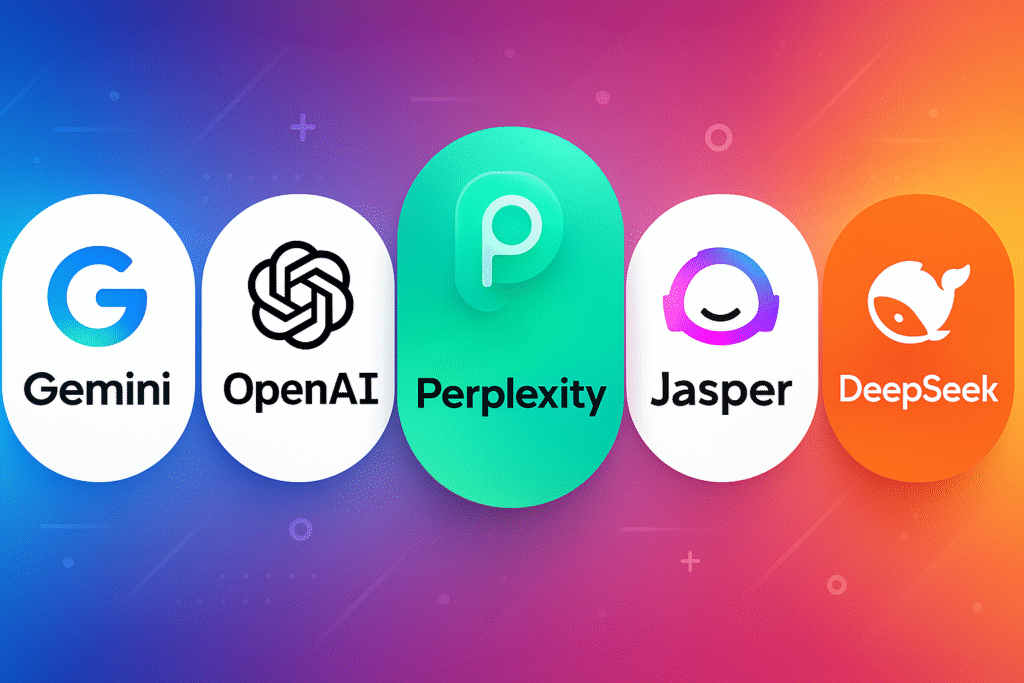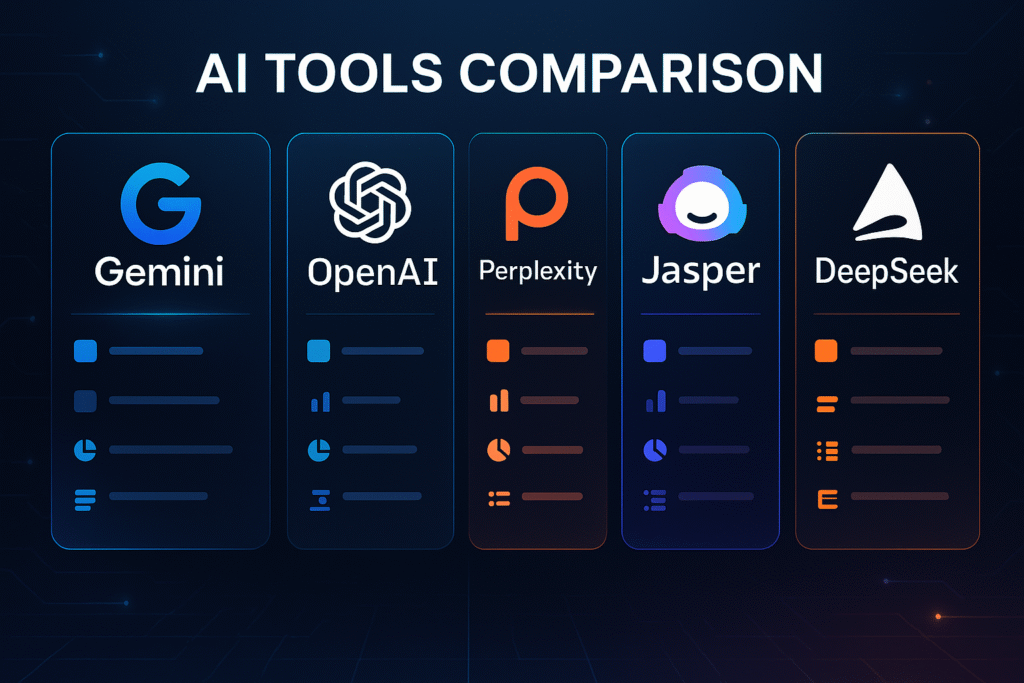
The landscape of artificial intelligence is expanding at a remarkable pace, with new models and platforms emerging constantly. Choosing the right AI tool can feel overwhelming, but understanding their unique strengths is key to unlocking their full potential. This guide offers a detailed AI tools comparison, breaking down the features of five major players: Google’s Gemini, OpenAI’s models, Perplexity, Jasper, and DeepSeek. Whether you’re a developer, marketer, writer, or researcher, we’ll help you find the best AI platform for your needs.
Introduction to AI Tools Comparison in 2025
Before diving into a head-to-head comparison, let’s get acquainted with each platform and what makes it unique.
- OpenAI: The creator of the famous GPT (Generative Pre-trained Transformer) models, including GPT-3.5 and GPT-4. OpenAI is known for its powerful, versatile large language models (LLMs) that excel at a wide range of tasks, from conversation to complex code generation.
Learn more at OpenAI’s official website - Gemini: Google’s answer to OpenAI. It’s a natively multimodal model, meaning it was designed from the ground up to understand and process text, images, audio, and video seamlessly. It comes in different sizes (Ultra, Pro, and Nano) for various applications.
Explore more about Gemini at Google’s AI page - Perplexity AI: This tool positions itself as a “conversational answer engine.” It combines the power of LLMs with real-time web search capabilities to provide accurate, cited answers to user queries, making it a powerful alternative to traditional search engines.
Try Perplexity AI here - Jasper: Built specifically for marketing and business content creation. Jasper offers a suite of templates, workflows, and brand voice features designed to help teams produce high-quality, on-brand content at scale.
Discover Jasper’s capabilities here - DeepSeek: An open-source model from DeepSeek AI that has gained attention for its exceptional coding and mathematical reasoning abilities. It is often favored by developers and technical users who need a powerful, freely available model.
Explore DeepSeek on GitHub
Feature-by-feature comparison
The table below summarizes core strengths (concise). After the table we deep-dive into each product and recommended use-cases.
| Platform | Strengths | Best use-case | Notable limitations |
|---|---|---|---|
| Gemini (Google) | Deep Google-product integrations, advanced multimodal (image + text + voice), conversational editing | Quick content drafts inside Google Docs/Gmail, image edits in Photos/Slides, multimodal workflows | Privacy/enterprise controls depend on Google Workspace tier; sometimes conservative safety filters. blog.google |
| OpenAI (GPT-5 family) | Strong coding & reasoning, agent frameworks, plugin/tooling ecosystem | Complex coding assistants, research agents, product integrations | Cost for top-tier models; integration & fine-tuning work required for enterprise grade. OpenAI+1 |
| Perplexity | Search-first answers with citations, research focused UI, new productivity tools (browser, email assistant) | Fast, citation-backed research, browsing workflows, inbox triage | May not match GPT-level creativity for long-form marketing pieces; premium features can be pricey. The Times of India+1 |
| Jasper | Marketing-first templates, brand voice control, content production pipelines | Long-form marketing, ad copy, social posts, SEO content at scale | Less suited for deep code tasks or scientific reasoning; specialized for marketing teams. Jasper+1 |
| DeepSeek | Lightweight chat, rapid iter cycle, localized features/agents | Quick prototyping, conversational assistants, regional deployments | Smaller userbase; fewer enterprise guarantees; roadmap evolving quickly. DeepSeek |
Deep dive — one platform at a time
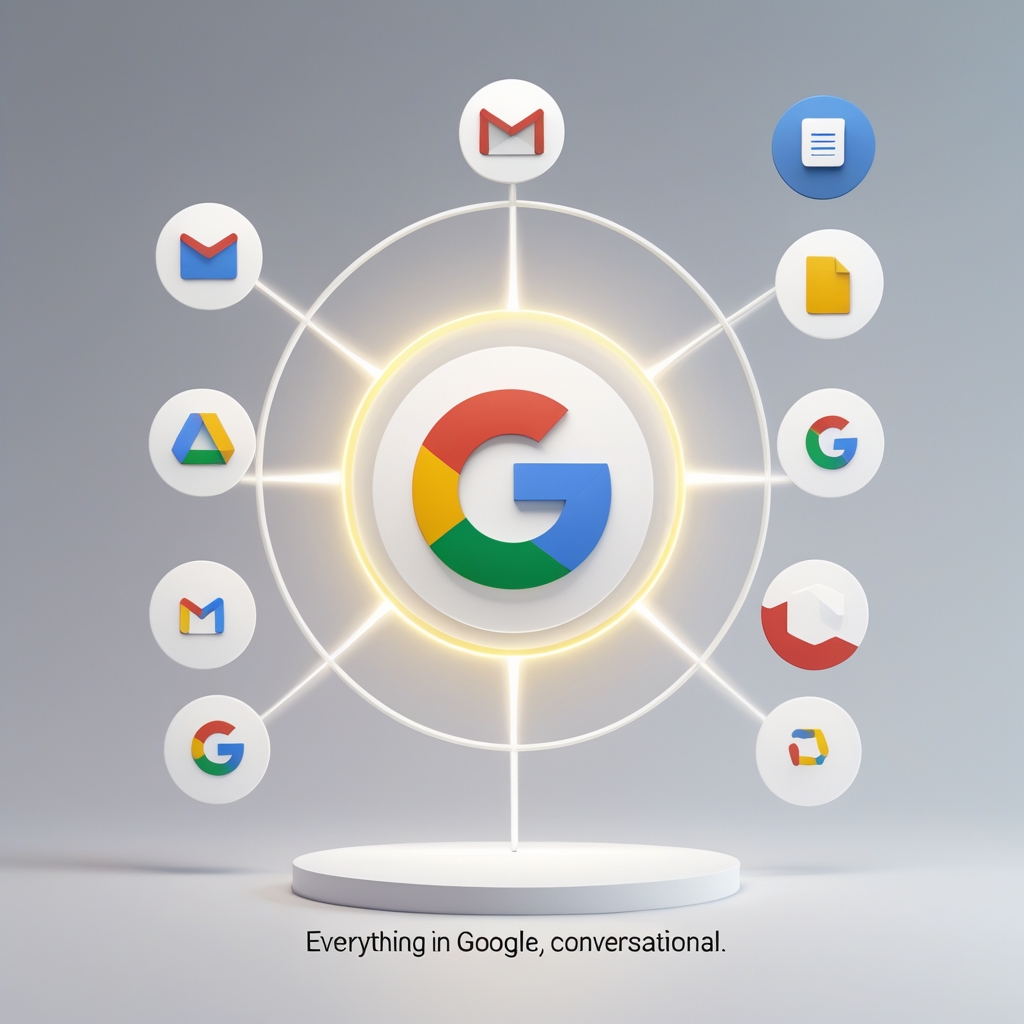
Google Gemini — “Everything in Google, conversational”
Strengths: Gemini is tightly integrated into Gmail, Docs, Google Photos and Search: think “ask your documents, edit images by voice, draft emails inside Gmail.” Google has positioned Gemini to be a general-purpose assistant with strong multimodal features and fast “flash” models for responsiveness. blog.google+1
When to choose Gemini:
- You live in the Google ecosystem (Gmail, Drive, Slides).
- You need multimodal editing (e.g., conversational photo edits in Google Photos).
- You want a quick assistant for drafts, summaries, and contextual search inside Google apps.
Limitations: Safety filters and corporate deployment options vary; advanced developer tooling lags some specialized OpenAI capabilities.
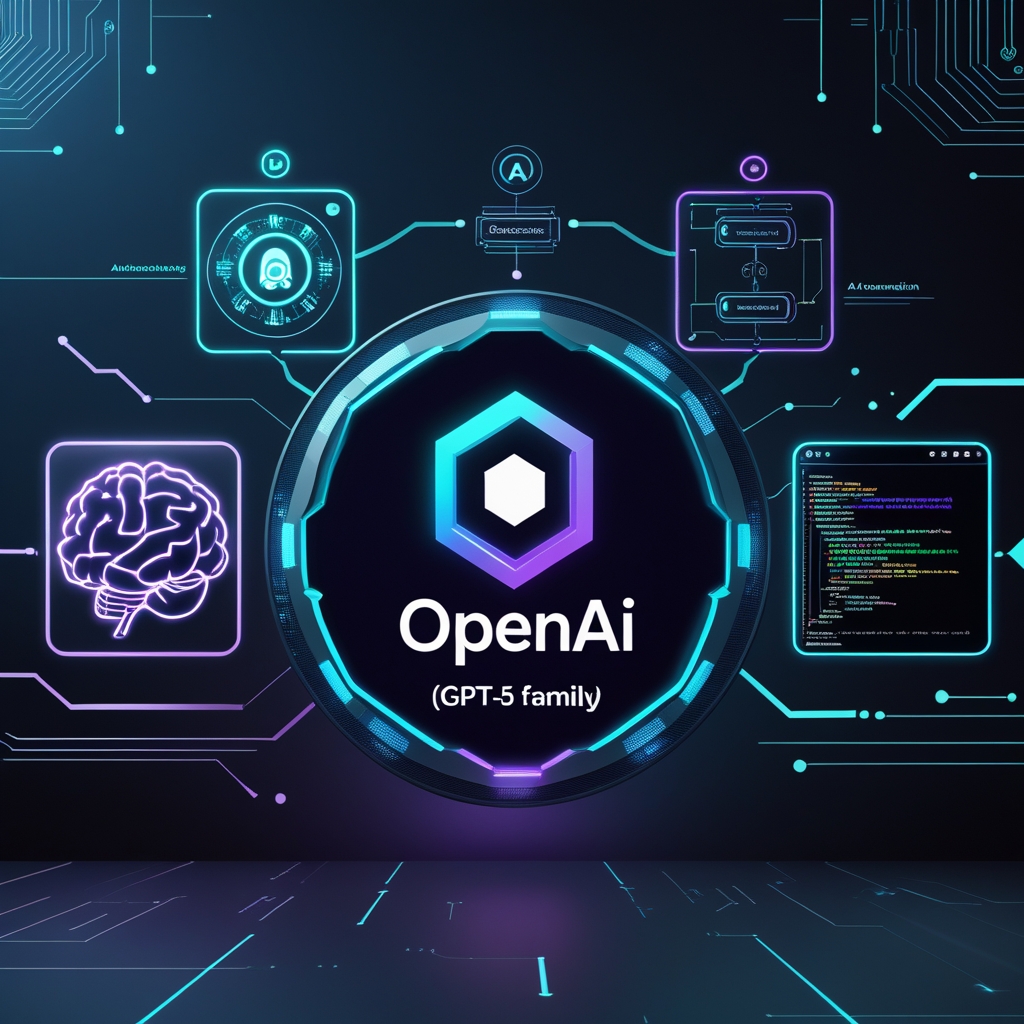
OpenAI (GPT-5 family) — “Powerful reasoning and agents”
Strengths: GPT-5 and related models focus on deep reasoning, agentic behavior, and coding. For development-heavy workflows and tools that require strong chain-of-thought and end-to-end task execution (e.g., build a script, debug it, and produce deployable code), OpenAI’s API/models are top-tier. OpenAI+1
When to choose OpenAI:
- You need a coding co-pilot or systems that perform multi-step reasoning.
- You want to build products that use agent frameworks and plugins.
- You require a powerful API and broad third-party ecosystem.
Limitations: Model costs for top models can be significant; integration and safety controls require engineering effort.
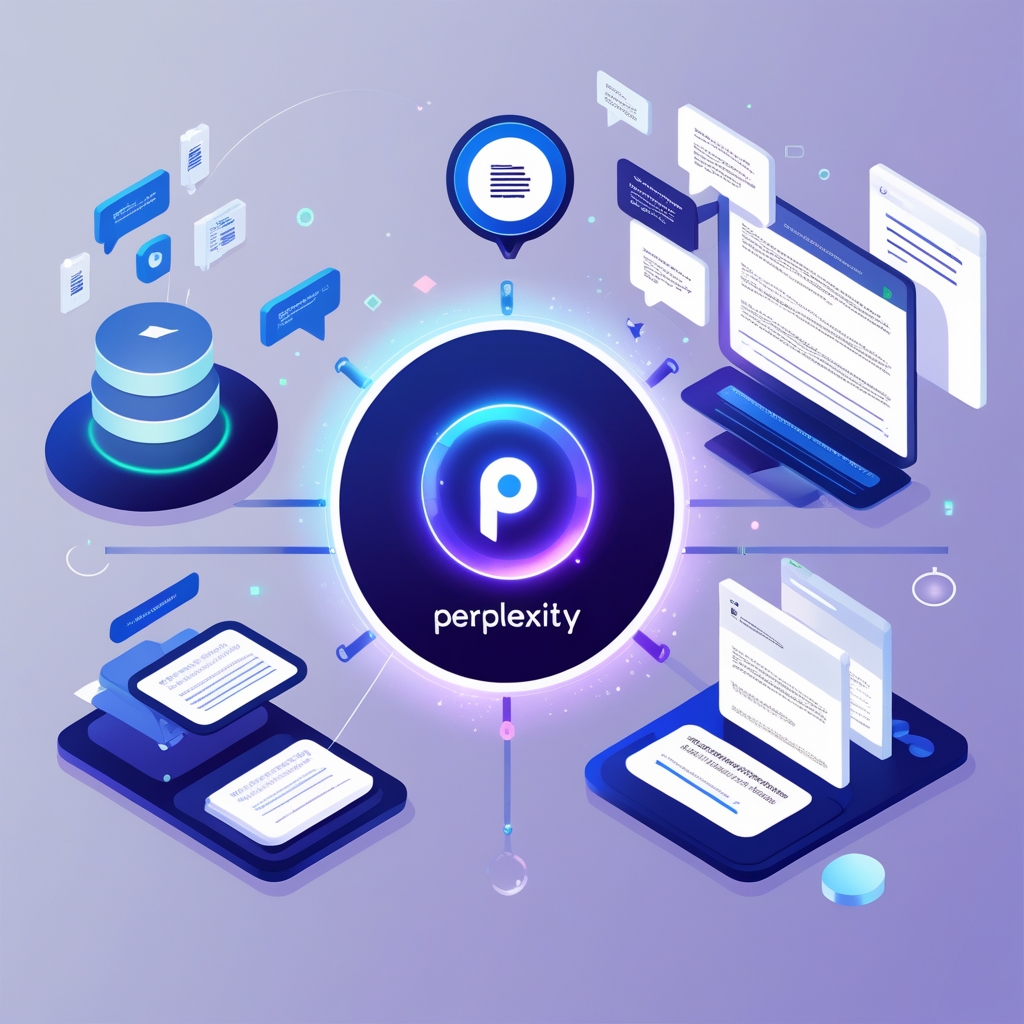
Perplexity — “Search-first with citations”
Strengths: Perplexity focuses on delivering concise, citation-backed answers and is evolving into a productivity hub (recent launches include the Comet browser and advanced inbox/email assistants). If you need verifiable answers and research-first workflows, Perplexity excels. Perplexity AI+2The Times of India+2
When to choose Perplexity:
- You want fast research with sources and minimal fuss.
- You prefer the AI to behave like a search assistant with summaries + links.
- You need the AI to help triage or draft emails in an inbox-focused workflow (premium). Windows Central
Limitations: Not primarily designed for high-volume marketing workflows or deep code generation.
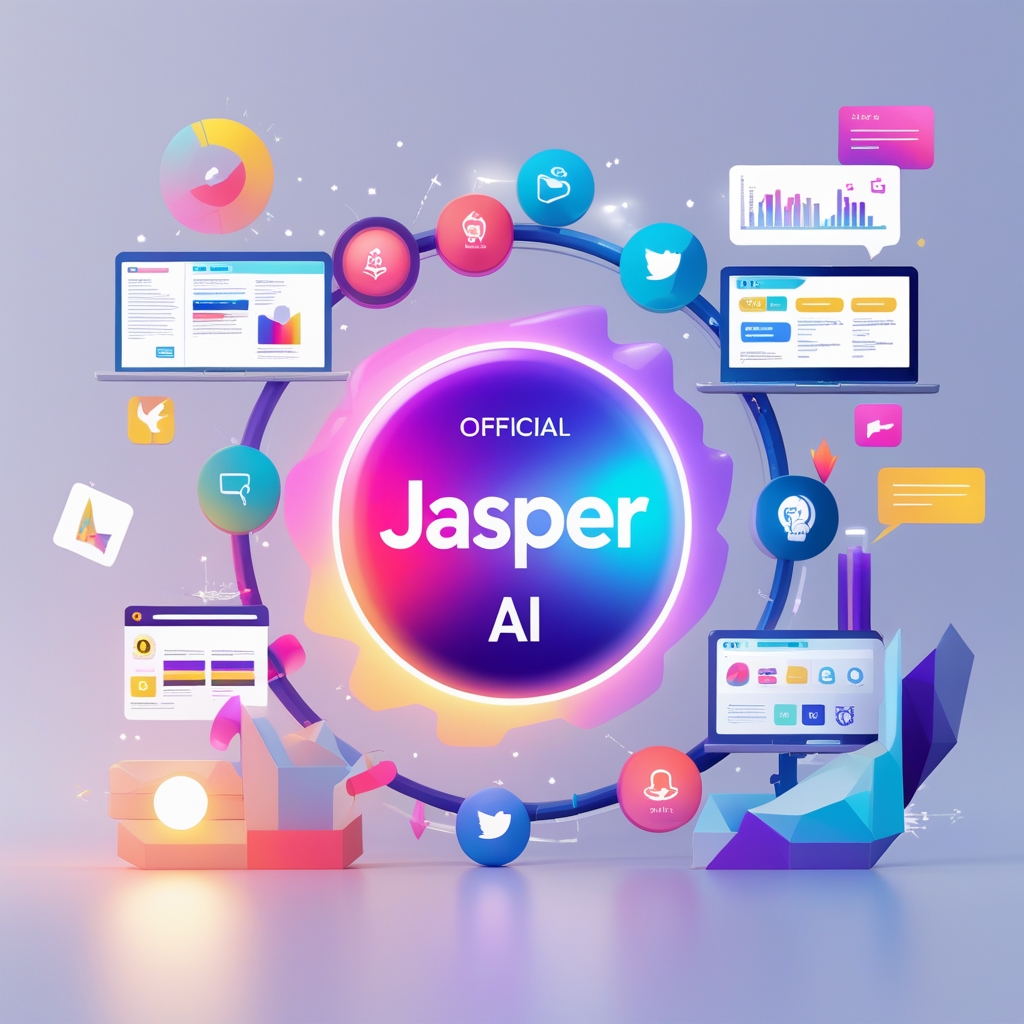
Jasper — “Marketing & content at scale”
Strengths: Jasper offers a marketing-first product: templates, brand voice control, SEO workflows, and team-oriented content pipelines. It’s built so content teams can produce blog posts, ads, and social content quickly. Jasper+1
When to choose Jasper:
- You run a marketing team creating high-volume content with consistent brand voice.
- You want built-in SEO templates and integrations for publishing workflows.
Limitations: Less focused on deep research citations or developer tooling.
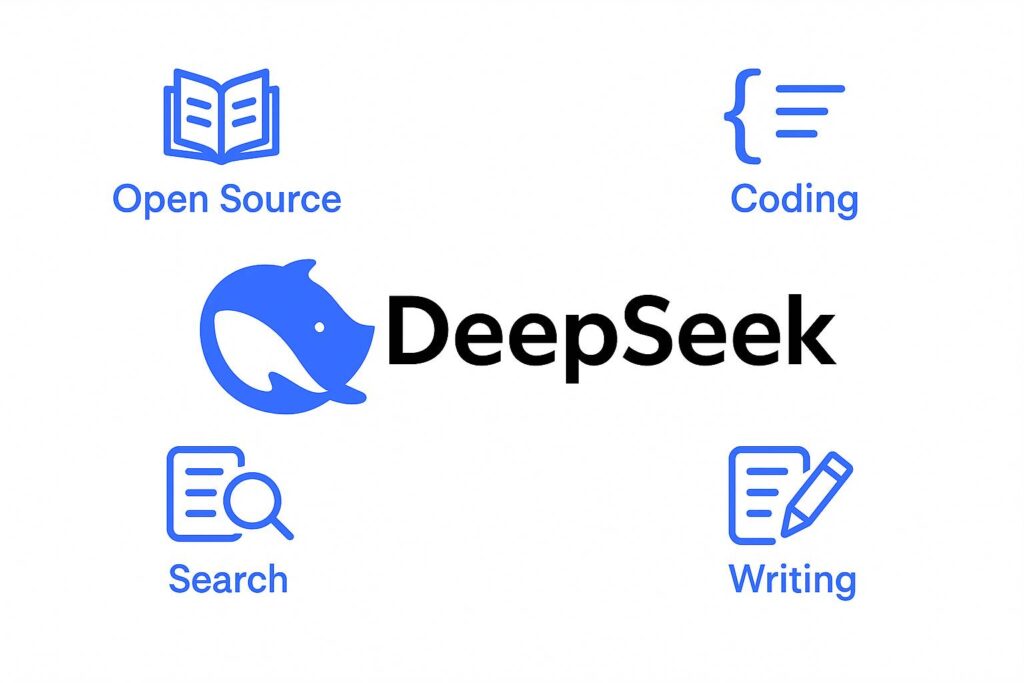
DeepSeek — “Nimble, experimental, all-in-one chat”
Strengths: DeepSeek positions itself as a flexible, fast-iterating AI with agent features and lightweight APIs — good for rapid prototyping, experimental agents, or users seeking an accessible chat-first tool. DeepSeek
When to choose DeepSeek:
- You want a low-friction chat tool for prototyping and smaller deployments.
- You care about experimentation and rapid feature rollouts.
Limitations: Smaller company means fewer enterprise guarantees and integrations than the big players.
Which is best for which purpose — practical recommendations
- Academic research & citation-backed answers: Perplexity (best when you need sources and quick summaries). Perplexity AI+1
- Everyday productivity inside email/docs/photos: Gemini (best for Google Workspace users). blog.google
- Complex software development, automated agents, or productizing AI: OpenAI (GPT-5 family) (best for coding, agents & enterprise APIs). OpenAI+1
- Marketing teams & content production at scale: Jasper (best for templates, brand voice, and SEO pipelines). Jasper
- Prototyping, experimental agents, lightweight chat products: DeepSeek (best for nimble teams and experimentation). DeepSeek
Pricing & access signals (high-level)
- Gemini: Free tier via Google apps; premium tiers (Google AI Ultra / Gemini Pro) for more rate limits and features. blog.google
- OpenAI: Tiered model access; GPT-5 and specialized models vary in price—API costs scale by model capability. OpenAI Platform
- Perplexity: Free basic search; Perplexity Max / premium features (e.g., Email Assistant) behind subscription. Windows Central
- Jasper: Marketing plans with Pro and Business tiers; free trials exist, pricing depends on seats & features. Jasper
- DeepSeek: Freemium + paid tiers, experimental roadmap; check official site for latest. DeepSeek
(Always confirm pricing pages before buying — vendors update plans frequently.)
Conclusion: What Most Users Think About the Top AI Tools
According to popular opinion, OpenAI remains the leading choice for overall performance and versatility. Its models, especially GPT-4, are highly regarded for their natural language understanding, creative output, and consistent reliability. Both individuals and businesses trust OpenAI for everything from brainstorming and professional writing to coding support.
Gemini is getting widespread attention for its seamless handling of text, images, and even video—all in one platform. Many users favor Gemini when working in Google’s ecosystem or on projects that call for true multimodal capabilities.
Perplexity AI has built a strong reputation as the go-to answer engine. Its ability to deliver current, accurate, and cited information makes it popular with students, researchers, and anyone seeking trustworthy, up-to-date facts.
Jasper stands out among marketers and business teams for its robust templates and brand voice controls. Its purpose-built environment streamlines content creation, which is why it’s widely recommended for marketing and scaling on-brand messaging.
DeepSeek is a favorite among developers and technical professionals, praised for its strong coding performance and open-source flexibility. While not as commonly used for general content tasks, its value in programming circles is hard to deny.
Ultimately, the consensus is that each tool shines in its area of expertise. Most people suggest choosing based on your primary need: OpenAI for general and creative tasks, Gemini for multimodal work and Google integration, Perplexity AI for factual research, Jasper for marketing, and DeepSeek for programming. Trying them out for your specific goals is the best way to find the perfect fit.

